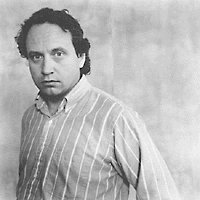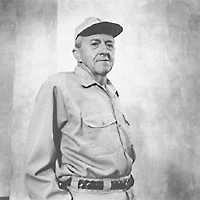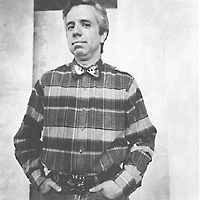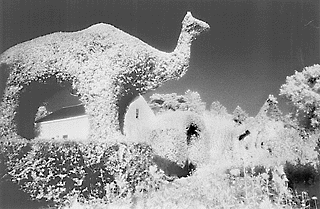Fast, Cheap & Out of Control
Interview With Filmmaker Errol Morris
By Jason Silverman, Fri., Nov. 14, 1997
|
|
Since his debut in 1978 with the pet cemetery film Gates of Heaven, Morris has refused to play by the cinéma vérité rules. Forgoing the hallmarks of Sixties and Seventies documentary filmmaking -- the "fly-on-the-wall" philosophy, and the shoot-with-available-light, hand-held camera look -- Morris has helped to create a new, distinctive style of nonfiction cinema. Morris' short but remarkable filmography includes explorations of small-town eccentrics (Vernon, Florida, 1981); a forgotten, unfairly tried convict (The Thin Blue Line, 1988); and the wheelchair-bound physicist Stephen Hawking (A Brief History of Time, 1992).
(Morris also directed a fiction feature in 1991, The Dark Wind, which is adapted from a Tony Hillerman novel and stars Lou Diamond Phillips and Fred Ward.) Through each of his films, Morris has pushed into new nonfiction territory and reaffirmed his position as the mad scientist of American cinema -- iconoclastic, idiosyncratic, and undaunted by conventional wisdom.
|
|
|
|
"There is something about this virtual connection that is very strong," Morris said during an interview from his Boston office. "Everyone is familiar with the dramatic value of direct eye contact, but this is the first time that there is a two-part connection going on, rather than a three-part connection. No longer is it the interviewer, the camera, and the subject; with the Interrotron, the conversation is between the camera/interviewer and the subject."
|
|
|
|
Morris' fascination with film style took root while he was studying philosophy at the University of California at Berkeley. He spent much of his spare time at the Pacific Film Archives, where he developed a circle of film-savvy friends that included Werner Herzog, who dared Morris to complete his first film. When the 30-year-old Morris unveiled Gates of Heaven, Herzog, as promised, boiled and ate his shoe in front of an audience. The entire episode was captured on film by Les Blank in a short film titled Werner Herzog Eats His Shoe. Herzog became a fan of Morris' work (he called Vernon, Florida "the greatest film ever made") as did Roger Ebert, who named Gates of Heaven in his list of the 10 best films of all time. However, critical acclaim hasn't paved any financial roads for Morris, who spent several years raising money for the project that was to become The Thin Blue Line. Morris has received a MacArthur Fellowship, a Guggenheim Fellowship, and three N.E.A. grants, but he continues to supplement his income with TV and commercial work.
|
|
Finances were one reason the Fast, Cheap footage sat unedited for several years. The initial interviews, shot in 1993, represent the bulk of the first Interrotron footage. Morris spent three days filming five men -- topiary gardener Mendonça, lion trainer Dave Hoover, mole-rat specialist Ray Mendez, robot scientist Rodney Brooks, and electric chair designer Fred Lucher (who will be the subject of an upcoming Morris film) -- in a studio outside of Boston. Morris and Oscar-winning director of photography Robert Richardson shot the film using more than a dozen different stocks and emulsions, including video, infrared, 16mm, Super-16mm, and 35mm. Richardson is one of the world's most sought-after cinematographers -- he has shot nearly all of Oliver Stone's films, as well as films for John Sayles (City of Hope, Eight Men Out), Rob Reiner (A Few Good Men), and Martin Scorsese (Casino). For Fast, Cheap, Richardson and Morris created a look that is exquisitely layered, filled with reprocessed and degraded images, grainy black-and-white and muted color.
Richardson later used the techniques developed with Morris for Fast, Cheap to much different effect, in Stone's Natural Born Killers. The film's narrative focal points are the Interrotron interviews, but Fast, Cheap also includes wonderful archival movie footage (increasingly a Morris trademark) and a number of impressionistic sequences, including the Mendonça scene.
"People may see this film as a documentary, as something uncontrolled, but suddenly, we found ourselves shooting a feature film," Morris explains. "We have always played with the ideas of what is real and unreal. If my nonfiction films have an element of spontaneity, of the uncontrolled, it is the fact that people are allowed to talk in an unrehearsed, spontaneous fashion." Given the freedom, Morris' subjects have occasionally talked themselves into corners, revealing their hidden agendas (in Gates of Heaven), their eccentricities (in Vernon, Florida), and even their outright dishonesty. The Thin Blue Line explored the then-closed murder case of Randall Adams, who had been convicted of killing a Dallas police officer and given the death penalty. Morris' detective work and his interviews with police officers and court officials revealed the many contradictions in officers' stories; the evidence was damning enough to cause the state to re-open the case. Adams was later exonerated and released from prison. Morris couldn't have known when he began filming The Thin Blue Line that his work would lead to Adams' release.
|
|
Morris does, however, seem to have a sense of the direction each of his films will take once the cameras start rolling. In Fast, Cheap, the four subjects do not know each other, do not interact, and at first seem to have little in common. As the film progresses, the philosophical connections between the men, though unstated, become increasingly evident. Themes quietly emerge. In that way, Fast, Cheap has much in common with Morris' earlier works. "Every film I've made has been a reaction to what we take to be traditional documentary," he says. "Gates of Heaven, for example, was conceived in part as a reaction to cinéma vérité -- throwing out those principles or turning them on their head. That movie is ostensibly about pet cemeteries, but it really isn't about pet cemeteries at all. Instead, there is a whole set of connections set up between these characters that are surprising and unexpected, and the scope of the film becomes much broader than you'd expect from the underlying subject matter. Gradually, these themes emerge, and begin to take over the movie. In Fast, Cheap, there are four characters who have little to do with each other, and whose life works are divergent.
"But it wasn't as though I went to a phone book and picked four men. I knew that in these four separate stories, themes would develop, and connections would be made. In Fast, Cheap, I've just done this with fewer characters, and, for the first time, I have no underlying story at all working for me." However, the film does have an emotional center. George Mendonça, the oldest of Fast, Cheap's subjects, persists in his craft -- creating and refining living sculptures out of hedges -- although he has no reason to believe his masterpieces will be maintained after his death. It is in large part Mendonça's Zen-like attitude ("Cut and wait, cut and wait" is his motto) that elevates Fast, Cheap into the realm of greatness. As Mendonça shapes his creatures in the rain, he provides an unspoken linkage between mortality and the creative spirit.
"I find him moving," Morris says. "And I identify with all four men. There is something about each one of their pursuits that is quixotic, but also wonderful."
Fast, Cheap & Out of Control opens Friday, November 14 at the Dobie Theatre.
Jason Silverman is a freelance writer and the programmer of the Taos Talking Picture Festival.













